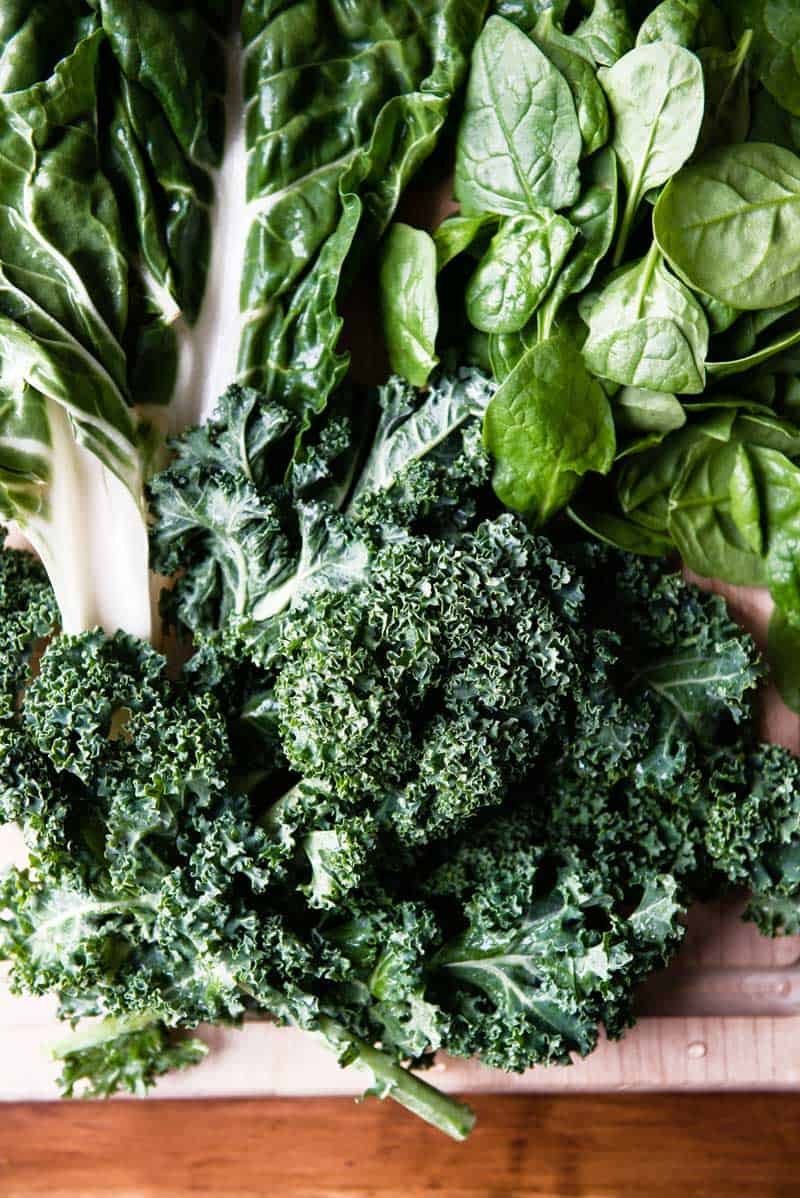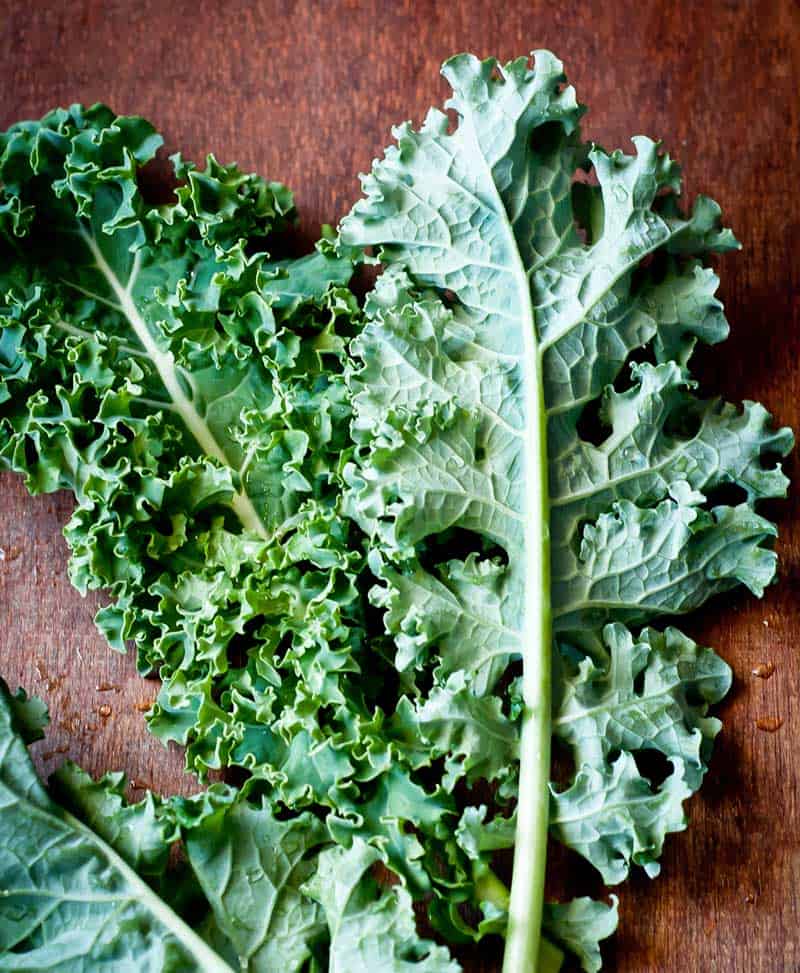The shining stars of green smoothies are the leafy greens— and today I’m taking a deep dive into my love for greens and why you should love them too.
What are Leafy Greens?
Leafy greens are super important for a healthy diet. They’re nutrient dense, green veggies that provide tons of vitamins and minerals. According to research by the US Department of Health and Human Services, a daily serving of leafy greens can lead to slower age-related cognitive decline.
Greens can be found as the tops of other plants (here’s looking at you, carrot tops), or as plants in their own right. Leafy greens come in all shapes, sizes, textures, shades, and seasons. They aren’t even all in the same plant family. If your taste buds have ever bulked at something dark green and leafy, never fear! I’ve got some great new options for you to blend.
The leafy greens list

I often talk about rotating your greens. This is because greens come from all different plant families, each offering different health benefits. Yet if spinach is your jam, no worries! Your body will tell you when its time for a leafy green change-up. Read on to learn about some different types of greens, as well as my fav options in each family.
Crucifers
Kale
Having a health issue? Kale can help with that. Seriously, kale is at the top of the superfood chain. With 684% of the recommended daily value of vitamin K, 206% of the RDV of vitamin A, and 134% of the RDV of vitamin C, this dark leafy green packs a health punch. The National Library of Medicine states that kale has the highest level of antioxidants when consumed raw, yet does retain some health benefits when cooked.
Collard
Like their other cruciferous family members, collard greens are great cancer fighters. They are also pretty good at helping your body digest foods properly with all the fiber inside. They are most popular as a steamed, dark leafy green, but adding them raw to your smoothies will provide greater health benefits.
Cabbage
Cabbage is yet another example of a cruciferous cancer fighting leafy green. This veggie can actually be purple, red, white, or green, but is definitely still considered a leafy green. I love using cabbage as a plant based taco shell, or blended in a smoothie. Loaded with fiber, folate, and vitamin B6, and antioxidants which help fight inflammation.
Bok Choy
This unique green vegetable is typically grown and harvested in China. Full of vitamins A and C, bok choy ranks high for nutrient density as well. All parts of the plant can be used: shredded in a salad or ramen, cooked in soup, or blended in a smoothie.
Arugula
More than just a garnish, this leafy green has a peppery taste and a full nutrient profile. 1 cup contains 27.7% of the RDV of vitamin K. It has a stronger flavor than other cruciferous greens on my list, yet is fun in salad, pesto, or as a pizza topping on my incredibly delicious plant based pizza recipe in Simple Green Meals.

Amaranth:
Spinach
It’s hard to beat spinach when talking about nutrient packed greens. Just one leaf contains a sampling of more than 20 different nutrients. The list of benefits is nearly as long as the amount of nutrients:
- cancer fighting
- blood pressure lowering
- bone strengthening
- cardiovascular helping
- brain boosting
- skin smoothing
- vision improving
- inflammation reducing
- energy increasing
Beet Greens
I recommend branching out and trying beet greens for your next smoothie! They include a wide variety of nutrients, and can easily be substituted in any recipe with spinach, kale, or chard. Our friends at Epicurious will kickstart your love for dark leafy beet greens with some of their fav recipes.
Chard
Looking to put a pep in you leafy green step? Chard is a colorful, dark leaf known for its ability to regulate the body’s blood sugar. Translation? If diabetes or maintaining blood sugar levels is a concern, then add this veggie to your regular rotation. Perfect for the afternoon smoothie pick-me-up!
Asteraceae:
Romaine Lettuce
Romaine lettuce is good for the heart and low in calories. The vitamin C and beta-carotene content help to lower cholesterol and prevent build up on artery walls, which reduces the risk of heart attack. Not a fan of salads? Then use romaine as a food wrap with some hummus + fresh veggies!
Apiaceae:
Carrot Tops
Who knew those frilly greens on the tops of carrots could come in handy? #nofoodwaste Filled with chlorophyll, which can fight against tumor growth and acts as a cleansing agent, carrot tops are the perfect addition to smoothies. If you really want to boost your next smoothie, toss in the carrot + its top.

How often should you rotate greens?
Most of the smoothie/meal recipes I create use kale or spinach. That’s because these are the most easily found + affordable leafy greens available at the grocery store. Plus, they are in different leafy green families, so it makes rotating my greens easy peasy.
Alkaloid Build Up
Why is it important to rotate through this leafy green list? All greens have small amounts of toxins. If you only consume greens from one family, your body may start to experience alkaloid build up. This is very rare, and easy to avoid. Just try a new/different leafy green every once in a while. I recommend rotating your greens once a week. This way, your body doesn’t get too much of a good thing in one leafy green family, and you get the chance to reward your body with new nutrients from a different green family.
Basically, by rotating greens on a regular basis, you avoid building up the toxins from one leafy green. And, this gives you a reason to try that new fun green you’re always eyeing at the farmers market. While our green smoothies are super easy to swap out one green for another, I’ve also got a meal planner full of plant based recipes. Rawk the Year makes finding new recipes a breeze, and helps you incorporate the whole rainbow into your week. This meal planner also equips you with the kitchen skills to change up your veggies with ease!
Freezing your leafy greens
Ever wonder how to use up all that beautiful produce you just bought, before it starts to wilt? Even though I make green smoothies daily, I still find that my greens never stay fresh as long as I need. To lengthen the shelf life of those leafy greens, and make rotating your greens as easy as opening your freezer, I came up with a way to freeze your greens. This way, you can have you greens and eat them too! Since I typically buy spinach and kale at Costco, I found that freezing them in ice cube trays then storing in freezer containers in the perfect solutions to maximizing the freshness. Plus, frozen greens can really help keep that smoothie cool.

The Ultimate Green Smoothie App
Our amazing app, Daily Blends, has 100s of recipes ready for you to work your way through the leafy greens list! Click here to get it.
What are your fav leafy greens? Drop and comment and let me know if this list has inspired you to try a new ingredient, or if you’ve got a new green for me to try!
from
https://simplegreensmoothies.com/plant-based-diet/leafy-greens
No comments:
Post a Comment